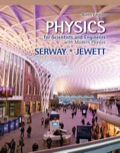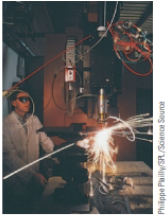
EBK PHYSICS FOR SCIENTISTS AND ENGINEER
9th Edition
ISBN: 8220100461262
Author: SERWAY
Publisher: Cengage Learning US
expand_more
expand_more
format_list_bulleted
Textbook Question
thumb_up100%
Chapter 34, Problem 34.27P
High-power lasers in factories are used to cut through cloth and metal (Fig. P33.15). One such laser has a beam diameter of 1.00 mm and generates an electric field having an amplitude of 0.700 MV/m at the target. Find (a) the amplitude of the magnetic field produced, (b) the intensity of the laser, and (c) the power delivered by the laser.
Figure P33.15

Expert Solution & Answer
Trending nowThis is a popular solution!

Students have asked these similar questions
No chatgpt pls will upvote
No chatgpt pls will upvote
A rod 12.0 cm long is uniformly charged and has a total charge of -20.0 μc. Determine the magnitude and direction of the electric field along the axis of the rod at a point
32.0 cm from its center.
361000
☑
magnitude
What is the general expression for the electric field along the axis of a uniform rod? N/C
direction toward the rod
Chapter 34 Solutions
EBK PHYSICS FOR SCIENTISTS AND ENGINEER
Ch. 34 - Prob. 34.1QQCh. 34 - What is the phase difference between the...Ch. 34 - Prob. 34.3QQCh. 34 - Prob. 34.4QQCh. 34 - If the antenna in Figure 33.11 represents the...Ch. 34 - Prob. 34.6QQCh. 34 - A radio wave of frequency on the order of 105 Hz...Ch. 34 - A spherical interplanetary grain of dust of radius...Ch. 34 - Prob. 34.2OQCh. 34 - A typical microwave oven operates at a frequency...
Ch. 34 - Prob. 34.4OQCh. 34 - Prob. 34.5OQCh. 34 - Which of the following statements are true...Ch. 34 - Prob. 34.7OQCh. 34 - Prob. 34.8OQCh. 34 - An electromagnetic wave with a peak magnetic field...Ch. 34 - Prob. 34.10OQCh. 34 - Prob. 34.11OQCh. 34 - suppose a creature from another planet has eyes...Ch. 34 - Prob. 34.2CQCh. 34 - Prob. 34.3CQCh. 34 - List at least three differences between sound...Ch. 34 - If a high-frequency current exists in a solenoid...Ch. 34 - Prob. 34.6CQCh. 34 - Prob. 34.7CQCh. 34 - Do Maxwells equations allow for the existence of...Ch. 34 - Prob. 34.9CQCh. 34 - What does a radio wave do to the charges in the...Ch. 34 - Prob. 34.11CQCh. 34 - An empty plastic or glass dish being removed from...Ch. 34 - Prob. 34.13CQCh. 34 - Prob. 34.1PCh. 34 - Prob. 34.2PCh. 34 - Prob. 34.3PCh. 34 - An election moves through a uniform electric field...Ch. 34 - A proton moves through a region containing a...Ch. 34 - Prob. 34.6PCh. 34 - Suppose you are located 180 in from a radio...Ch. 34 - A diathermy machine, used in physiotherapy,...Ch. 34 - The distance to the North Star, Polaris, is...Ch. 34 - Prob. 34.10PCh. 34 - Review. A standing-wave pattern is set up by radio...Ch. 34 - Prob. 34.12PCh. 34 - The speed of an electromagnetic wave traveling in...Ch. 34 - A radar pulse returns to the transmitterreceiver...Ch. 34 - Figure P34.15 shows a plane electromagnetic...Ch. 34 - Verify by substitution that the following...Ch. 34 - Review. A microwave oven is powered by a...Ch. 34 - Why is the following situation impossible? An...Ch. 34 - ln SI units, the electric field in an...Ch. 34 - At what distance from the Sun is the intensity of...Ch. 34 - If the intensity of sunlight at the Earths surface...Ch. 34 - Prob. 34.22PCh. 34 - A community plans to build a facility to convert...Ch. 34 - Prob. 34.24PCh. 34 - Prob. 34.25PCh. 34 - Review. Model the electromagnetic wave in a...Ch. 34 - High-power lasers in factories are used to cut...Ch. 34 - Consider a bright star in our night sky. Assume...Ch. 34 - What is the average magnitude of the Poynting...Ch. 34 - Prob. 34.30PCh. 34 - Review. An AM radio station broadcasts...Ch. 34 - Prob. 34.32PCh. 34 - Prob. 34.33PCh. 34 - Prob. 34.34PCh. 34 - A 25.0-mW laser beam of diameter 2.00 mm is...Ch. 34 - A radio wave transmits 25.0 W/m2 of power per unit...Ch. 34 - Prob. 34.37PCh. 34 - Prob. 34.38PCh. 34 - A uniform circular disk of mass m = 24.0 g and...Ch. 34 - The intensity of sunlight at the Earths distance...Ch. 34 - Prob. 34.41PCh. 34 - Assume the intensity of solar radiation incident...Ch. 34 - A possible means of space flight is to place a...Ch. 34 - Extremely low-frequency (ELF) waves that can...Ch. 34 - A Marconi antenna, used by most AM radio stations,...Ch. 34 - A large, flat sheet carries a uniformly...Ch. 34 - Prob. 34.47PCh. 34 - Prob. 34.48PCh. 34 - Two vertical radio-transmitting antennas are...Ch. 34 - Prob. 34.50PCh. 34 - What are the wavelengths of electromagnetic waves...Ch. 34 - An important news announcement is transmitted by...Ch. 34 - In addition to cable and satellite broadcasts,...Ch. 34 - Classify waves with frequencies of 2 Hz, 2 kHz, 2...Ch. 34 - Assume the intensity of solar radiation incident...Ch. 34 - In 1965, Arno Penzias and Robert Wilson discovered...Ch. 34 - The eye is most sensitive to light having a...Ch. 34 - Prob. 34.58APCh. 34 - One goal of the Russian space program is to...Ch. 34 - A microwave source produces pulses of 20.0GHz...Ch. 34 - The intensity of solar radiation at the top of the...Ch. 34 - Prob. 34.62APCh. 34 - Consider a small, spherical particle of radius r...Ch. 34 - Consider a small, spherical particle of radius r...Ch. 34 - A dish antenna having a diameter of 20.0 m...Ch. 34 - The Earth reflects approximately 38.0% of the...Ch. 34 - Review. A 1.00-m-diameter circular mirror focuses...Ch. 34 - Prob. 34.68APCh. 34 - Prob. 34.69APCh. 34 - You may wish to review Sections 16.4 and 16.8 on...Ch. 34 - Prob. 34.71APCh. 34 - Prob. 34.72APCh. 34 - Prob. 34.73APCh. 34 - Prob. 34.74APCh. 34 - Prob. 34.75APCh. 34 - Prob. 34.76CPCh. 34 - A linearly polarized microwave of wavelength 1.50...Ch. 34 - Prob. 34.78CPCh. 34 - Prob. 34.79CP
Knowledge Booster
Learn more about
Need a deep-dive on the concept behind this application? Look no further. Learn more about this topic, physics and related others by exploring similar questions and additional content below.Similar questions
- A certain brand of freezer is advertised to use 730 kW h of energy per year. Part A Assuming the freezer operates for 5 hours each day, how much power does it require while operating? Express your answer in watts. ΜΕ ΑΣΦ ? P Submit Request Answer Part B W If the freezer keeps its interior at a temperature of -6.0° C in a 20.0° C room, what is its theoretical maximum performance coefficient? Enter your answer numerically. K = ΜΕ ΑΣΦ Submit Request Answer Part C What is the theoretical maximum amount of ice this freezer could make in an hour, starting with water at 20.0°C? Express your answer in kilograms. m = Ο ΑΣΦ kgarrow_forwardDescribe the development of rational choice theory in sociology. Please includearrow_forwardA-E pleasearrow_forward
- A 11.8 L gas tank containing 3.90 moles of ideal He gas at 26.0°C is placed inside a completely evacuated insulated bell jar of volume 39.0 L .A small hole in the tank allows the He to leak out into the jar until the gas reaches a final equilibrium state with no more leakage. Part A What is the change in entropy of this system due to the leaking of the gas? ■ ΜΕ ΑΣΦ AS = ? J/K Submit Request Answer Part B Is the process reversible or irreversible?arrow_forwardA-E pleasearrow_forwardThree moles of an ideal gas undergo a reversible isothermal compression at 20.0° C. During this compression, 1900 J of work is done on the gas. For related problem-solving tips and strategies, you may want to view a Video Tutor Solution of Entropy change in a free expansion. Part A What is the change of entropy of the gas? ΤΕ ΑΣΦ AS = Submit Request Answer J/Karrow_forward
- 5.97 Block A, with weight 3w, slides down an inclined plane S of slope angle 36.9° at a constant speed while plank B, with weight w, rests on top of A. The plank is attached by a cord to the wall (Fig. P5.97). (a) Draw a diagram of all the forces acting on block A. (b) If the coefficient of kinetic friction is the same between A and B and between S and A, determine its value. Figure P5.97 B A S 36.9°arrow_forwardPlease take your time and solve each part correctly please. Thank you!!arrow_forwardhelp me answer this with explanations! thanks so mucharrow_forward
- No chatgpt pls will upvote Alreadyarrow_forwardWhat fuel economy should be expected from a gasoline powered car that encounters a total of 443N of resistive forces while driving down the road? (Those forces are from air drag, rolling resistance and bearing losses.) Assume a 30% thermodynamic efficiency.arrow_forwardNo chatgpt pls will upvotearrow_forward
arrow_back_ios
SEE MORE QUESTIONS
arrow_forward_ios
Recommended textbooks for you
 Principles of Physics: A Calculus-Based TextPhysicsISBN:9781133104261Author:Raymond A. Serway, John W. JewettPublisher:Cengage Learning
Principles of Physics: A Calculus-Based TextPhysicsISBN:9781133104261Author:Raymond A. Serway, John W. JewettPublisher:Cengage Learning Physics for Scientists and EngineersPhysicsISBN:9781337553278Author:Raymond A. Serway, John W. JewettPublisher:Cengage Learning
Physics for Scientists and EngineersPhysicsISBN:9781337553278Author:Raymond A. Serway, John W. JewettPublisher:Cengage Learning Physics for Scientists and Engineers with Modern ...PhysicsISBN:9781337553292Author:Raymond A. Serway, John W. JewettPublisher:Cengage Learning
Physics for Scientists and Engineers with Modern ...PhysicsISBN:9781337553292Author:Raymond A. Serway, John W. JewettPublisher:Cengage Learning Physics for Scientists and Engineers: Foundations...PhysicsISBN:9781133939146Author:Katz, Debora M.Publisher:Cengage Learning
Physics for Scientists and Engineers: Foundations...PhysicsISBN:9781133939146Author:Katz, Debora M.Publisher:Cengage Learning Physics for Scientists and Engineers, Technology ...PhysicsISBN:9781305116399Author:Raymond A. Serway, John W. JewettPublisher:Cengage Learning
Physics for Scientists and Engineers, Technology ...PhysicsISBN:9781305116399Author:Raymond A. Serway, John W. JewettPublisher:Cengage Learning College PhysicsPhysicsISBN:9781305952300Author:Raymond A. Serway, Chris VuillePublisher:Cengage Learning
College PhysicsPhysicsISBN:9781305952300Author:Raymond A. Serway, Chris VuillePublisher:Cengage Learning

Principles of Physics: A Calculus-Based Text
Physics
ISBN:9781133104261
Author:Raymond A. Serway, John W. Jewett
Publisher:Cengage Learning

Physics for Scientists and Engineers
Physics
ISBN:9781337553278
Author:Raymond A. Serway, John W. Jewett
Publisher:Cengage Learning

Physics for Scientists and Engineers with Modern ...
Physics
ISBN:9781337553292
Author:Raymond A. Serway, John W. Jewett
Publisher:Cengage Learning

Physics for Scientists and Engineers: Foundations...
Physics
ISBN:9781133939146
Author:Katz, Debora M.
Publisher:Cengage Learning

Physics for Scientists and Engineers, Technology ...
Physics
ISBN:9781305116399
Author:Raymond A. Serway, John W. Jewett
Publisher:Cengage Learning

College Physics
Physics
ISBN:9781305952300
Author:Raymond A. Serway, Chris Vuille
Publisher:Cengage Learning
What Are Electromagnetic Wave Properties? | Physics in Motion; Author: GPB Education;https://www.youtube.com/watch?v=ftyxZBxBexI;License: Standard YouTube License, CC-BY